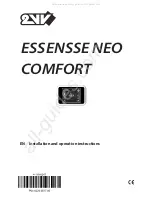
●
Lay cables being susceptible to interference or sources of interference at the
highest possible distance from each other.
●
The interference immunity of signal and bus cables increases if the cables are
laid close to the earth potential.
●
If possible, avoid laying long cables and make sure that they are installed in
areas being subject to low interference.
●
Avoid long parallel paths with cables being either susceptible to interference or
interference sources.
●
For the connection of remote position transmitters, screened cables must be
used.
Type of current, mains
voltage and mains fre-
quency
Type of current, mains voltage and mains frequency must match the data on the
motor name plate.
Figure 9: Motor name plate (example)
[1]
Type of current
[2]
Mains voltage
[3]
Mains frequency (for 3-ph and 1-ph AC motors)
Connecting cables
●
For device insulation, appropriate (voltage-proof) cables must be used. Specify
cables for the highest occurring rated voltage.
●
Use connecting cable with appropriate minimum rated temperature.
●
For connecting cables exposed to UV radiation (outdoor installation), use UV
resistant cables.
5.2.
Connection with AUMA plug/socket connector
Cross sections AUMA plug/socket connector:
●
Power terminals (U1, V1, W1, U2, V2, W2): max. 6 mm² flexible/10 mm² solid
●
PE connection : max. 6 mm² flexible/10 mm² solid
●
Control contacts (1 to 50): max. 2.5 mm²
17
SQ 05.2 – SQ 14.2/SQR 05.2 – SQR 14.2 Control unit: electronic (MWG)
AC 01.2 Non-Intrusive
Electrical connection
















































